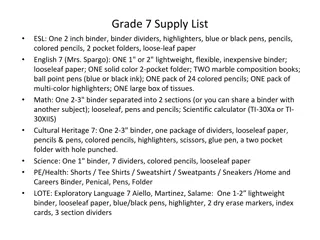
Understanding Lists in Python Programming
Dive into the world of lists in Python programming with this comprehensive content covering list initialization, accessing elements, managing out-of-bounds indexes, and solving practical problems using lists. Learn about storing multiple values efficiently and accessing elements with ease.
Download Presentation

Please find below an Image/Link to download the presentation.
The content on the website is provided AS IS for your information and personal use only. It may not be sold, licensed, or shared on other websites without obtaining consent from the author. If you encounter any issues during the download, it is possible that the publisher has removed the file from their server.
You are allowed to download the files provided on this website for personal or commercial use, subject to the condition that they are used lawfully. All files are the property of their respective owners.
The content on the website is provided AS IS for your information and personal use only. It may not be sold, licensed, or shared on other websites without obtaining consent from the author.
E N D
Presentation Transcript
CSc 110, Spring 2018 Lecture 19: lists Adapted from slides by Marty Stepp and Stuart Reges
Can we solve this problem? Consider the following program (input underlined): How many days' temperatures? 7 Day 1's high temp: 45 Day 2's high temp: 44 Day 3's high temp: 39 Day 4's high temp: 48 Day 5's high temp: 37 Day 6's high temp: 46 Day 7's high temp: 53 Average temp = 44.6 4 days were above average.
Why the problem is hard We need each input value twice: to compute the average (a cumulative sum) to count how many were above average We could read each value into a variable... but we: don't know how many days are needed until the program runs don't know how many variables to declare We need a way to declare many variables in one step.
Lists list: object that stores many values. element: One value in a list. index: A 0-based integer to access an element from an list. index 0 1 -9 49 2 -8 -2 3 -7 26 4 -6 5 5 -5 17 6 -4 -6 7 -3 84 8 -2 72 9 -1 3 -10 12 value element 0 element 4 element 9
List initialization name = [value, value, value] Example: numbers = [12, 49, -2, 26, 5, 17, -6] index 0 1 2 3 4 5 6 value 12 49 -2 26 5 17 -6 Useful when you know what the list's elements will be name = [value] * count Example: numbers = [0] * 4 index 0 1 2 3 value 0 0 0 0
Accessing elements name[index] name[index] = value # access # modify Example: numbers = [0] * 2 numbers[0] = 27 numbers[1] = -6 print(numbers[0]) if (numbers[1] < 0): print("Element 1 is negative.") index 0 1 value 27 -6
Out-of-bounds Legal indexes to use []: between list's length and the list's length - 1. Reading or writing any index outside this range with [] will cause an IndexError: list assignment index out of range Example: data = [0] * 10 print(data[0]) # okay print(data[9]) # okay print(data[-20]) # error print(data[10]) # error index 0 1 2 3 4 5 6 7 8 9 value 0 0 0 0 0 0 0 0 0 0
Lists and for loops It is common to use for loops to access list elements. for i in range(0, 8): print(str(numbers[i]) + " ", end='') print() # output: 0 4 11 0 44 0 0 2 Sometimes we assign each element a value in a loop. for i in range(0, 8): numbers[i] = 2 * i index 0 1 2 3 4 5 6 7 value 0 2 4 6 8 10 12 14
len() Use len() to find the number of elements in a list. for i in range(0, len(numbers)): print(numbers[i] + " ", end='') # output: 0 2 4 6 8 10 12 14 What expressions refer to: The last element of any list? The middle element?
Lists and for loops You can also loop directly over lists, just as with strings list = [1, 3, 6, 23, 43, 12] for number in list: print(str(number + " ", end='') print() # output: 1 3 6 23 43 12
Weather question Use a list to solve the weather problem: How many days' temperatures? 7 Day 1's high temp: 45 Day 2's high temp: 44 Day 3's high temp: 39 Day 4's high temp: 48 Day 5's high temp: 37 Day 6's high temp: 46 Day 7's high temp: 53 Average temp = 44.6 4 days were above average.
Weather answer # Reads temperatures from the user, computes average and # days above average. def main(): days = int(input("How many days' temperatures? ")) temps = [0] * days # list to store days' temperatures sum = 0 for i in range(0, days): # read/store each day's temperature temps[i] = int(input(("Day " + (i + 1) + "'s high temp: "))) sum += temps[i] average = sum / days count = 0 # see if each day is above average for i in range(0, days): if (temps[i] > average): count += 1 # report results print("Average temp = " + str(average)) print(str(count) + " days above average")
Weather question 2 Modify the weather program to print the following output: Type in a temperature or "done" to finish Day 1's high temp: 45 Day 2's high temp: 44 Day 3's high temp: 39 Day 4's high temp: 48 Day 5's high temp: 37 Day 6's high temp: 46 Day 7's high temp: 53 Day 7's high temp: done Average temp = 44.6 4 days were above average.
List declaration name = [] Example: numbers = [] Creates an empty list index value
List functions Function append(x) extend(L) Description Add an item to the end of the list. Equivalent to a[len(a):] = [x]. Extend the list by appending all the items in the given list. Equivalent to a[len(a):] = L insert(i, x) Inserts an item at a given position. i is the index of the element before which to insert, so a.insert(0, x) inserts at the front of the list. remove(x) pop(i) Removes the first item from the list whose value is x. Errs if there is no such item. Removes the item at the given position in the list, and returns it. a.pop() removes and returns the last item in the list. clear() index(x) count(x) sort() reverse() copy() Remove all items from the list. Returns the index in the list of the first item whose value is x. Errs if there is no such item. Returns the number of times x appears in the list. Sort the items of the list Reverses the elements of the list Return a copy of the list.
Weather 2 answer # Reads temperatures from the user, computes average and # days above average. def main(): print("Type in a temperature or \"done\" to finish") temps = [] # list to store days' temperatures sum = 0 done = input("Day 1's high temp: ") day = 1 while(done != "done"): # read/store each day's temperature done = int(done) sum += done temps.append(done) done = input(("Day " + str(day + 1) + "'s high temp: ")) day += 1 average = sum / day count = 0 # see if each day is above average for i in range(0, day - 1): if (temps[i] > average): count += 1 # report results print("Average temp = " + str(average)) print(str(count) + " days above average")
Weather question 3 Modify the weather program to print the following output: How many days' temperatures? 7 Day 1's high temp: 45 Day 2's high temp: 44 Day 3's high temp: 39 Day 4's high temp: 48 Day 5's high temp: 37 Day 6's high temp: 46 Day 7's high temp: 53 Average temp = 44.6 4 days were above average. Temperatures: [45, 44, 39, 48, 37, 46, 53] Two coldest days: 37, 39 Two hottest days: 53, 48
Weather answer 3 # Reads temperatures from the user, computes average and # days above average. def main(): days = int(input("How many days' temperatures? ")) temps = [0] * days # list to store days' temperatures sum = 0 for i in range(0, days): # read/store each day's temperature temps[i] = int(input(("Day " + (i + 1) + "'s high temp: "))) sum += temps[i] average = sum / days count = 0 # see if each day is above average for i in range(0, days): if (temps[i] > average): count += 1 # report results print("Average temp = " + str(average)) print(str(count) + " days above average") print("Temperatures: " + str(temps))) temps.sort() print("Two coldest days: " + str(temps[0]) + ", " + str(temps[1])) print("Two hottest days: " + str(temps[-1]) + ", " + str(temps[-2]))
"list mystery" problem traversal: An examination of each element of an list. What element values are stored in the following list? a = [1, 7, 5, 6, 4, 14, 11] for i in range(0, len(a) 1): if (a[i] > a[i + 1]): a[i + 1] = a[i + 1] * 2 index index 0 0 1 1 2 2 3 3 4 4 5 5 6 6 value value 1 7 10 12 8 14 22






















